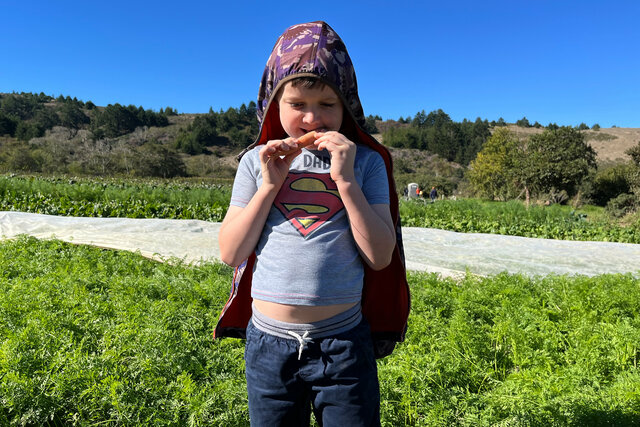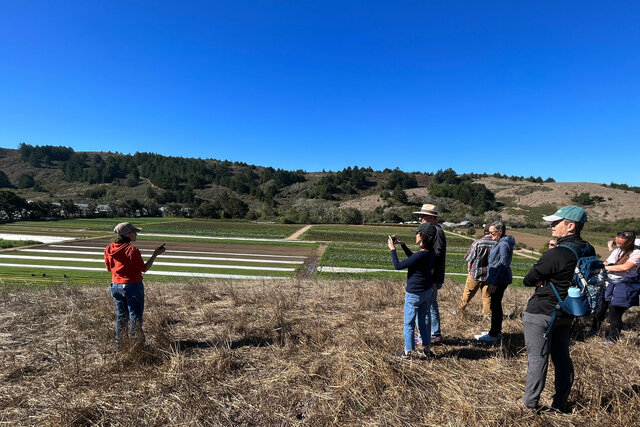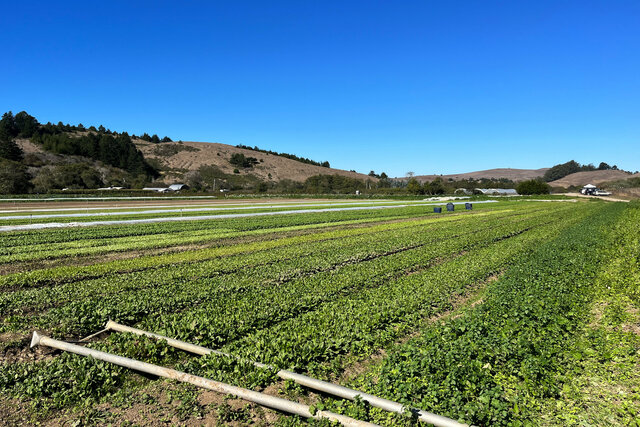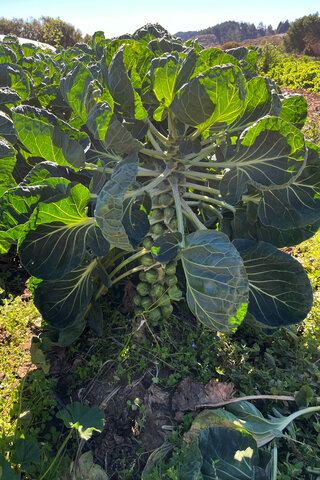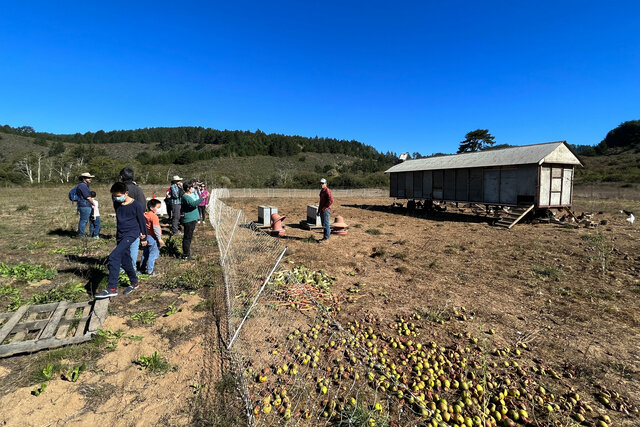Fifth Crow
Started: 2023-12-10 13:49:23
Submitted: 2023-12-10 16:46:15
Visibility: World-readable
Visiting an organic farm in Pescadero
Last summer Kiesa signed up for a community-supported agriculture farm share from Fifth Crow Farm, which delivered fresh produce weekly throughout the summer to a pick-up in a neighborhood near us in Santa Cruz. This summer she signed up again, so we enjoyed a constant stream of whatever happened to be in season any particular week. (This led to something of a boom-and-bust cycle. As I write this it's the middle of December and Kiesa still hasn't remembered that we have to actually get tomatoes from the grocery store again, because they'd reliably show up every week in the farm share.)
The farm held an open house at the end of October, giving us the opportunity to see where we get some of our food.
Fifth Crow Farm is located outside of Pescadero, up the coast from Santa Cruz along state highway 1. The route took us on a narrow two-lane road leading into the hills; along the way we encountered a car that had flipped and was sitting neatly in the lane for oncoming traffic, giving just enough space for us to pass. It wasn't clear how recently the car had flipped. There were no people nearby who would have been involved in the collision, but a sheriff's deputy sat waiting in a cruiser behind the flipped car, presumably waiting for a tow truck. (By the time we returned the vehicle had been removed and the site was clear except for broken glass on the pavement.)
We parked at the farm and waited for the tour that would take us around the farm. We waited near the end of a field growing row crops, giving me the opportunity to walk down the edge of the field to try to identify all of the crops growing there. Several of the rows were planted with carrots, and someone indicated that it would be acceptable for us to pick and eat carrots growing in the field, so I got Julian to pull a carrot out of the sandy ground, wash it off the best we could, and eat it right there in the field.
One of the farm's owners arrived to begin the tour. By this point we had a sizable group, probably fifty people waiting to take the tour. Many visitors had come over the mountain from the Peninsula and Silicon Valley.
The tour took us up a grassy hill overlooking the farm, giving us a commanding view of the fields filled with row crops that made up the front portion of the farm, nestled in a long valley along a small creek draining northwards. From there we descended to look at the herd of goats doing weed control on a small pasture along the driveway, under the control of an aggressive herding dog and a more-laid-back human goatherd. The goats were provided by a local non-profit that was trying to build up its herds and infrastructure for providing weed-control services, and they were still trying to figure out how to take meat and milk from the herd while growing the herd.
We walked down the length of the front field filled with row crops, some of them recently planted with young greens that might not survive the coming winter. The farm tried to produce around the year, but that was complicated by the seasonal nature of farming, even in our relatively temperate coastal California climate.
We saw the partially enclosed greenhouse where the las of this season's tomatoes were growing, and our guide encouraged us to pick and eat whatever we wanted. The middle of the fields were planted with strawberries, with some of the berries still growing on the plants. The rows of strawberries were elevated about a foot above the narrow aisle between the rows, and each row was covered in black plastic to retain water, prevent erosion, and control weeds. I've seen fields of strawberries laid out like this before while driving by the field, but I've never gotten a chance to see it up close. Our guide again encouraged us to pick and eat strawberries, and I ate several, but it was hard work bending over to find and pick the strawberries on the narrow rows.
Much of the farm was planted with various cultivars of brassica, including one section planted with Brussels sprouts. The sprouts started appearing in the farm-share distributions a week after our tour, so it's possible I ate some of the very vegetables I saw and photographed here.
The tour wrapped up and I wandered around a bit, looking at the greenhouses growing peppers (which I ate regularly, when they appeared in our farm share distribution every week), the orchards filled with apple trees, and chicks growing in a protected outdoor chicken run, enclosed in a thin wire mesh to protect them from hawks. There was a demonstration making cider (in this case, it was just apple juice) from apples, first mashing them in a mill and then pressing them to extract the juice. I tasted the fresh-pressed juice and it was sweet and tangy.
One thing that struck me about the row plants was that they were packed more closely than I thought was recommended by the nursery tags I've seen, but they were thriving with the water and nutrients they were being given. I'm going to interpret this as permission to pack my plants in my own garden more closely than I have.
We ate pizza from a food truck for lunch, then joined another tour of the back 40, an adjacent parcel on the other side of the creek. This involved crossing the creek on a shaky footbridge with a thin rope as a handrail. The bridge gave the impression of an extension ladder stretched across the gap covered by aluminum panels borrowed from a construction scaffold.
We had a different guide for this tour, another partner in the farm whose expertise emphasized the farming part more than the organic part. We saw another set of fields, much of it fallow for the oncoming winter, but some planted with winter greens. At the far side of the fields was a free-range chicken pasture, with two large chicken coops on wheels inside a yard-sized chunk of land surrounded by electric fence. The coop and the chickens were moved around the land to rotate their impact on the pasture, and the chickens were watched by a couple of dogs, who protected the chickens from predators.
We headed back through the fields of row-crops and back across the shaky footbridge towards our car. It was interesting to see the farm and to see where some of our food is grown. The farm's owners and operators believed in the benefits of organic farming and wanted to create their own piece of sustainable agriculture, tucked away in a valley somewhere on the rolling foothills of the Coast Range above the Pacific Ocean in rural San Mateo County. But the one thing I wondered was if the wholesale rejection of conventional agriculture and the dogmatic emphasis on specific farming techniques is the best overall approach for everyone. We have eight billion people on this planet and it's difficult to imagine feeding everyone using small-scale organic farming. Even in my own household most of our food comes from large-scale commercial agriculture via conventional grocery stores; it's not practical for us to meet our nutrition requirements using exclusively small-scale organic farming, and we are considerably more privileged than the vast majority of people in our own community and in the world as a whole. I think both organic farming and conventional farming have important lessons they can offer: organic farming emphasizes high-quality produce and lower-impact land use, while conventional farming provides the scale to make a difference for everyone.
